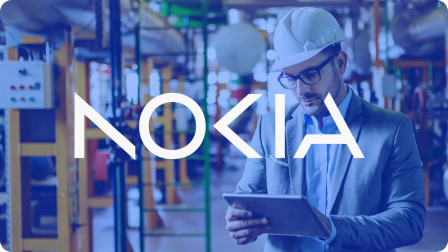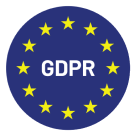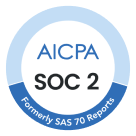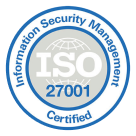Unlock the Secret Power of Call Center Voice Analytics
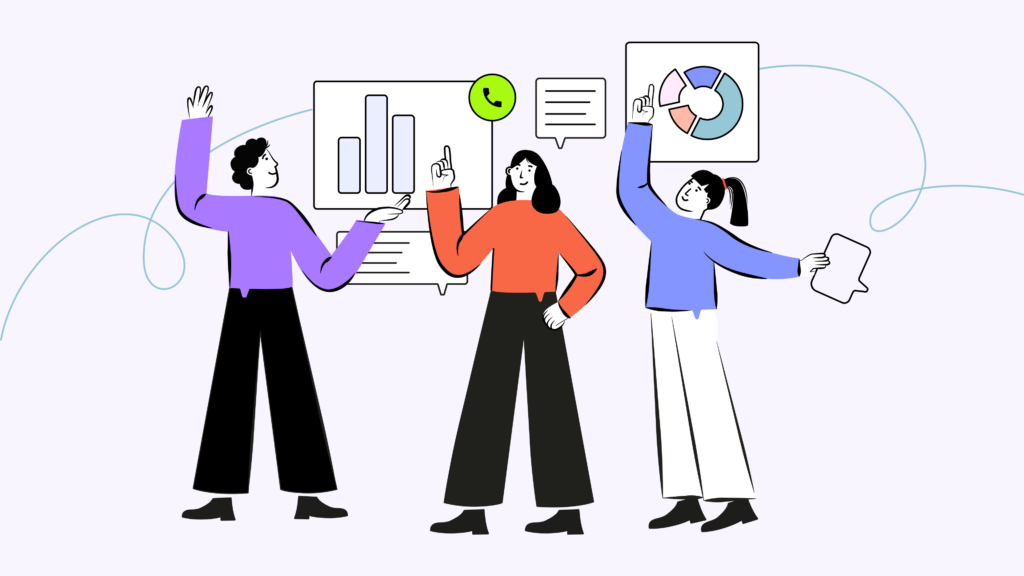
By uncovering the hidden meanings behind words, speech analysis can improve customer satisfaction by 10% and cut costs by as much as 30%. How is it possible?
When speaking with a customer, a simple ‘I need more time’ can mean anything from ‘call me later’ to ‘I’m not interested’—it all depends on the tone. How you interpret that can lead to a closed deal or a bad review online.
Fortunately, you no longer have to rely on intuition alone. Call center voice analytics can uncover emotions, intentions, and even unspoken truths in every customer interaction. From the very first ‘hello,’ it analyzes each word, tone, and cue of interest.
By leveraging speech analysis, call center analytics decodes all calls for you. It transforms conversations into data-backed strategies that enhance understanding of customer needs and enable personalized service and targeted coaching.
In this article, we’ll explain what voice analytics is, how it works, its benefits, and how to implement it effectively.
Key Takeaways:
- Voice analytics is more than just transcription. It analyzes how something is said—tone, pace, emotion—revealing intentions and hidden feelings in conversations.
- Speech and voice analysis has changed the game. It allows agents to adjust their sales pitch on the fly and fine-tune customer support with smart suggestions.
- It’s coaching, compliance, and forecasting all in one. Voice analytics monitors 100% of interactions, improves training, and anticipates issues like churn.
- The magic behind it: AI, NLP, and Machine Learning. These technologies transform thousands of calls into strategic data, ready to guide decisions and boost ROI.
Uncover the hidden insights in every customer call. Try CloudTalk and start decoding your conversations today.
What Is Speech Analytics in a Call Center?
Speech analytics is the technology that captures, transcribes, and analyzes spoken conversations to extract valuable insights and information. It leverages artificial intelligence (AI) to provide reliable data and in-depth analysis.
Call center voice analytics solutions use this tool to detect emotions and intentions during calls, analyzing audio patterns like tone, pace, and speech pauses—all automatically.
How Speech Analytics Works
Speech analytics uses a combined sequence of advanced technologies to automatically analyze voice data from customer interactions. Here’s a breakdown of the technical process involved:
- Speech Recognition (ASR – Automatic Speech Recognition): Converts spoken language into text, breaking audio signals into phonetic units for transcription.
- Natural Language Processing (NLP): Analyzes transcribed text to understand context, extract meaning, and identify intent and urgency in conversations.
- Sentiment Analysis: Detects emotions like frustration or happiness by analyzing tone, pitch, and pace of voice to gauge customer feelings during calls.
- Keyword and Topic Detection: Identifies critical words or phrases like “buy” or “cancel” to flag important moments and capture customer intent.
- Real-Time and Post-Call Analysis: Offers live feedback during calls and detailed reports afterward, helping agents adjust and improve over time.
- Machine Learning and AI: Continuously improves analysis accuracy, adapting to accents, dialects, and speech patterns to deliver more precise insights.

Voice Analytics vs. Speech Analytics
Generally speaking, “voice analytics” and “speech analytics” are used interchangeably. However, for some providers, they can have distinct meanings. So, it’s worth taking a closer look at their differences.
Voice analytics is often seen as analyzing all aspects of a conversation, such as tone, emotion, and sentiment, while speech analytics focuses specifically on the words spoken. In this sense, speech analytics looks at what is said, while voice analytics examines how it’s said.
Here’s a table with the main differences.
Aspect
Voice Analytics
Speech Analytics
What does it analyze?
Tone of voice, emotions, pace, and vocal characteristics
Content of spoken words (transcription and meaning)
Main focus
How things are said (intonation, stress)
What is said (keywords, phrases)
Primary Technology
Sentiment Analysis
Natural Language Processing (NLP)
Practical example
“The customer sounds frustrated with the offer.”
“The customer requested a refund.”
Only a minority uses this distinction between the terms, and today, most call center voice analytics technologies offer both content (words) and sentiment. Therefore, we’ll continue to use ‘speech analytics’ and ‘voice analytics’ interchangeably throughout this guide.
Behind the words, there are emotions. Discover how to read them with Sentiment Analysis.
Why is Voice Analytics Important for Call Centers?
Every day, a call center handles thousands of interactions, each packed with valuable insights. However, without the right tools, this wealth of data often goes untouched.
With voice analytics, call centers can tap into this treasure trove of information and uncover a range of benefits, including:
- Enhance Customer Satisfaction: Your team better understands customer needs, improving service quality and driving a 10% increase in customer satisfaction¹.
- Cut Costs Effectively: Companies can achieve cost savings of 20-30%¹ by optimizing their contact center operations through better data insights.
- Improve Efficiency: In-depth insights and automation tools help companies optimize staffing, eliminate manual tasks, and speed up problem-solving.
- Targeted Coaching: Analytics allow for more personalized agent coaching by identifying individual strengths and weaknesses, improving agent performance.
- Enhanced Compliance Monitoring: With speech analytics, companies can better monitor regulatory compliance and address issues in real-time.
How Voice Analytics Can Benefit You: Real-World Case Scenarios
Now that we know the areas where voice analytics can transform your business, let’s take a closer look at how it works in action. Below are real-world case scenarios that demonstrate how speech analytics makes a tangible impact on everyday operations.
Create Better Customer Experiences
Speech analytics software gives call centers a real “feel” for what customers are going through. By picking up on emotions and tone, agents can respond with more empathy and understanding, handling issues fast.
CloudTalk’s Sentiment Analysis, for example, detects whether a customer is frustrated, happy, or somewhere in between. Agents can adjust their approach on the spot, making every conversation smoother and more satisfying.
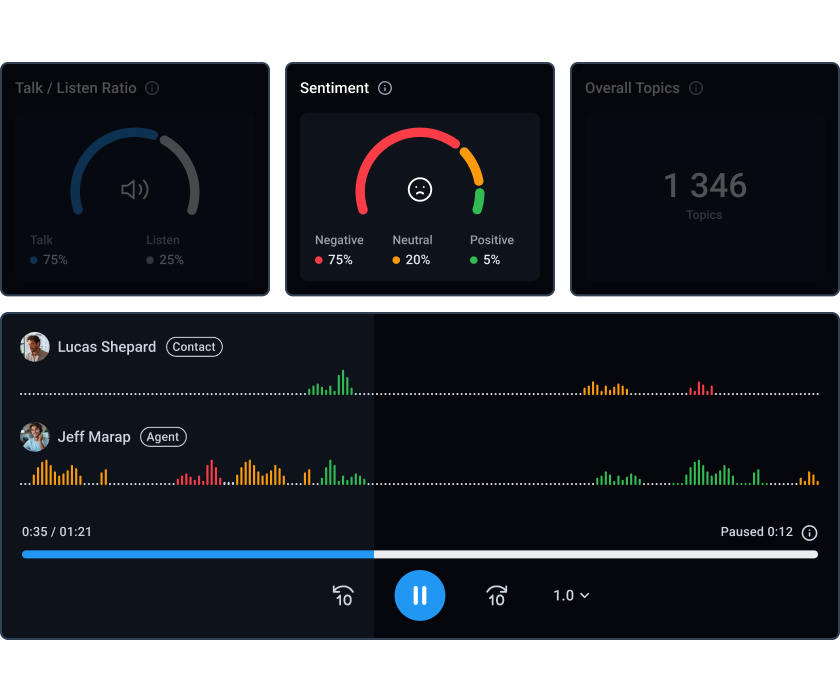
Meet Sarah, a Customer Support Rep at a Software Company.
Sarah is handling a call from Mark, a long-time user who recently upgraded his subscription. On the surface, Mark seems calm as he explains that he hasn’t received the promised features.
However, with Sentiment Analysis, Sarah detects the underlying disappointment in his tone. She adjusts her approach by acknowledging his long-term loyalty, prioritizing his request, and bringing in a specialist to resolve the issue right away.
Coach Agents with Tailored Guidance
Voice analytics takes call monitoring beyond the basics, turning raw data into real-time intelligence. It doesn’t just track traditional call performance metrics like First Call Resolution; it gives you a deep understanding of how to approach customers.
Call center voice analytics goes beyond just identifying the emotions behind the words—it also extracts key topics from conversations, giving you insights into what’s trending with customers.
With all this extra information, every call becomes an opportunity for personalized coaching, refining strategies, and enhancing agent performance.

Meet Tom, a Team Lead at a Telecom Provider.
Tom notices that one of his newer agents, Emily, seems to be struggling with technical support calls. She has been handling a lot of calls involving the topic “network outages”, but her first-call resolution rate isn’t improving.
With this insight, Tom offers Emily tailored coaching, suggesting she follow a more detailed script for handling outages. After a week of personalized guidance, Emily’s confidence grows, and her first-call resolution rate jumps by 30%.
Increase Efficiency and Productivity
By automatically analyzing and categorizing each call, voice analytics drastically reduces the time agents spend on manual notes and reports.
Features like Call Transcription, Automatic Call Summaries, and follow-up tagging free agents to focus on what really matters: the next call.
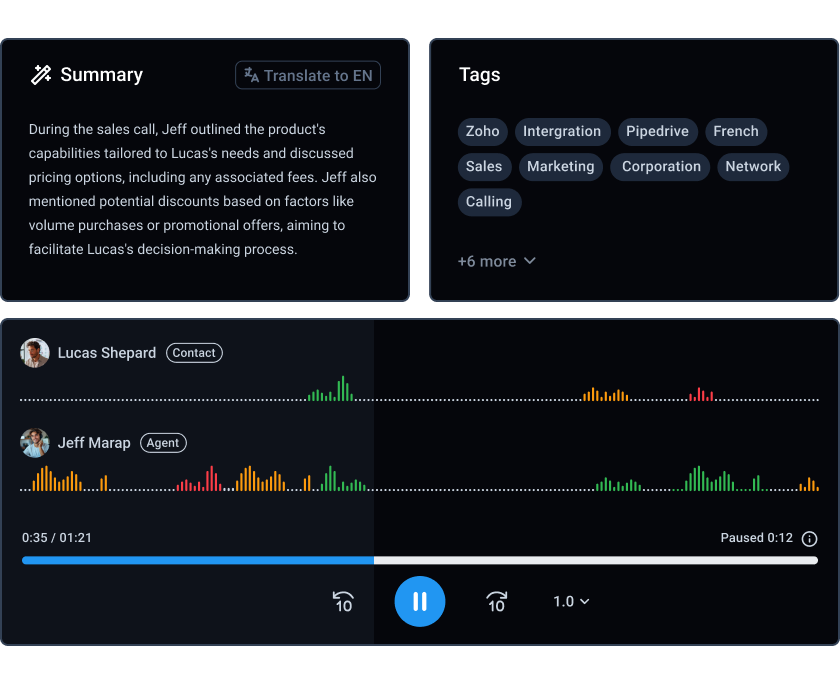
Meet Anna, a Call Center Manager at a Healthcare Provider.
Anna’s team used to spend a lot of time manually taking notes and generating reports. Voice analytics has automated these processes through call transcription and summary generation, freeing up time for agents to focus on assisting patients.
Real-time speech analytics also helps Anna identify recurring issues, such as common questions. This approach enables her team to resolve patient concerns more quickly, boosting productivity by 20% while maintaining top-quality service.
Streamline Compliance Monitoring
In industries with strict regulations, voice analytics plays a crucial role. It automatically monitors, transcribes, and stores calls, ensuring company policies and security guidelines.
Speech analytics gives agents real-time insights to help them stay on course and avoid saying or asking anything that might violate regulatory guidelines. The voice analytics software monitors all calls and notifies agents if they stray too far from the script.
This promotes accountability across the team and helps minimize the risk of non-compliance with regulations, such as HIPAA and CCPA.
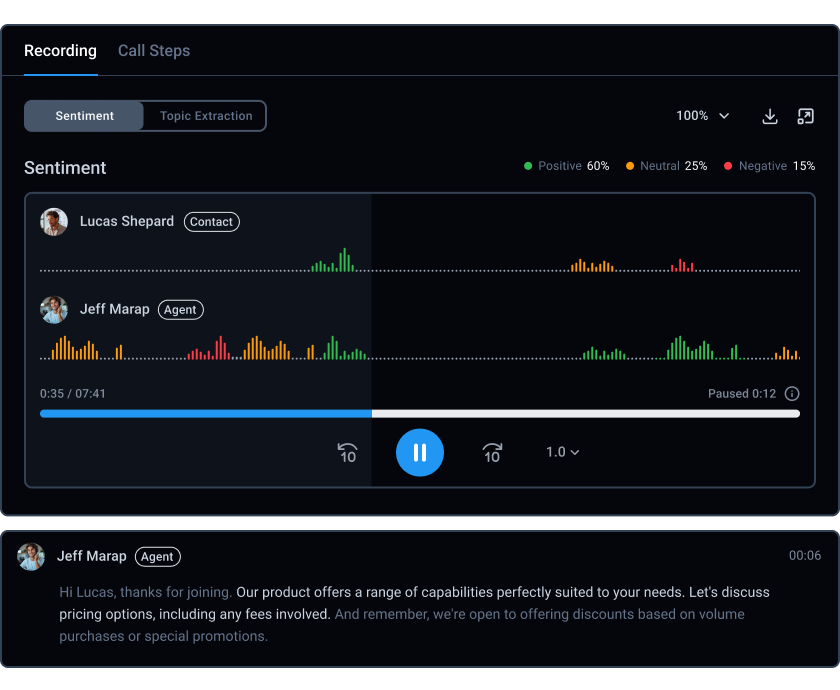
Meet David, a CS Manager at a Financial Services Company.
Recently, David’s team received a warning after an agent mistakenly shared personal financial information without proper authorization. To prevent this from happening again, he set up triggers and real-time notifications in their call analytics system.
During a subsequent call, an agent was about to discuss a customer’s credit score but was immediately flagged by the system. David quickly stepped in to guide the agent, preventing a potential compliance violation and ensuring the team stayed on track.
Optimize Your Strategy and Make Smarter Decisions
The volume of data your contact center collects can sometimes feel like a mountain to climb. With thousands of calls coming in every day, even if each call is just a few minutes long, it quickly adds up.
Voice analytics platforms make it easy to cut through the noise. With CloudTalk’s AI Analytics, you can track and analyze specific keywords like “upgrade,” “refund,” or “renew.” This means you can zero in on the conversations that matter most to you.
Using the same principle, voice analytics also helps you spot products, services, or features your competitors offer but you might be missing. This gives you valuable insights into how the market is moving, so you can adjust your own strategies.
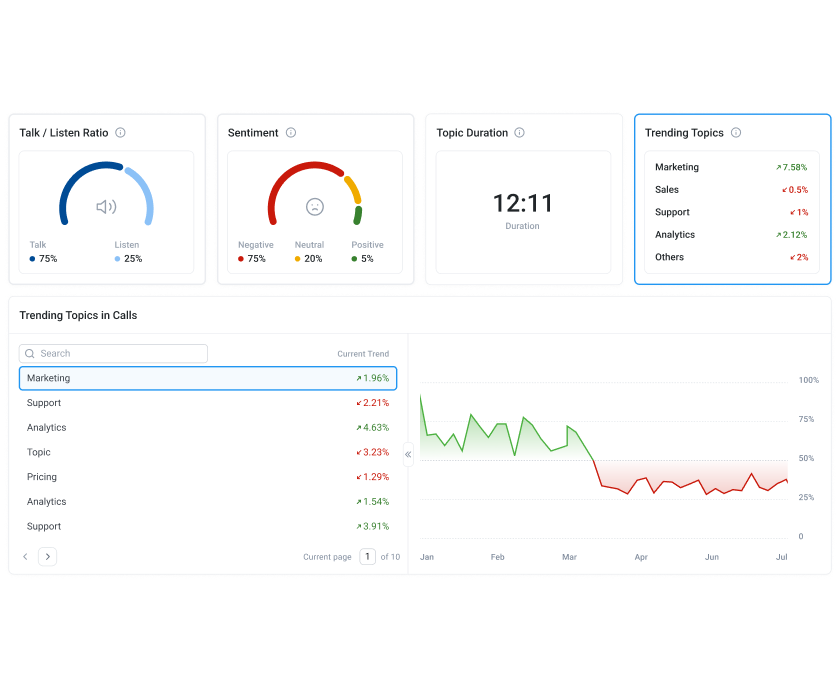
Meet Carlos, a Marketing Director at a B2B Tech Company.
Carlos has been trying to understand why their new software solution isn’t picking up steam in the market. After leveraging Topic Extraction, he discovers that potential customers are repeatedly asking about features his company doesn’t provide.
Recognizing a clear gap in the product, Carlos proposes adding those in-demand features to better align with customer needs. Just three months later, the company sees a 20% increase in leads and a 10% jump in conversion rates.
Unlock the “Secret Agent Mode” in Your Call Center
Think of voice analytics as a secret agent that doesn’t need disguises or fancy gadgets. Its mission is to work quietly behind the scenes during calls, transforming data into valuable insights about your customers.
It decodes every conversation and whisper that flows through your call center, giving you a powerful Intel Unit to refine your strategy, train your agents, and impress your customers.
CloudTalk doesn’t deal in secret services—it’s all transparent and easy to understand. But it can be your very own intelligence agency, providing valuable insights straight from the other side: your customers.
Request a free demo and discover how every call can work to your advantage. No gimmicks, no magic—just powerful voice analytics, ready to go.
CloudTalk analyzes all your calls and brings deep insights to the surface. Book a demo to see how it works.
Source:
FAQs
What is a speech analytics call center?
A speech analytics call center uses AI to analyze customer conversations, extracting valuable insights to improve service and efficiency.
What is a speech analytics contact center?
Speech analytics contact center analyzes spoken conversations, detecting emotions, keywords, and trends to improve decision-making and customer service.
How to use speech analytics?
To use speech analytics, you need to implement a call center voice analytics software. It converts speech to text to understand the conversation’s meaning, while analyzing vocal tones and emotions. It then provides valuable insights to improve service and performance.
How to analyze voice call data?
Voice call data is analyzed using speech analytics software that transcribes, detects emotions, and identifies key phrases for actionable insights.
What is a speech analytics call center?
A speech analytics call center uses advanced software to analyze customer interactions, providing insights to enhance customer experience and performance.
What is an analytics call center?
An analytics call center uses data analysis tools to track and improve call performance, customer satisfaction, and operational efficiency.
